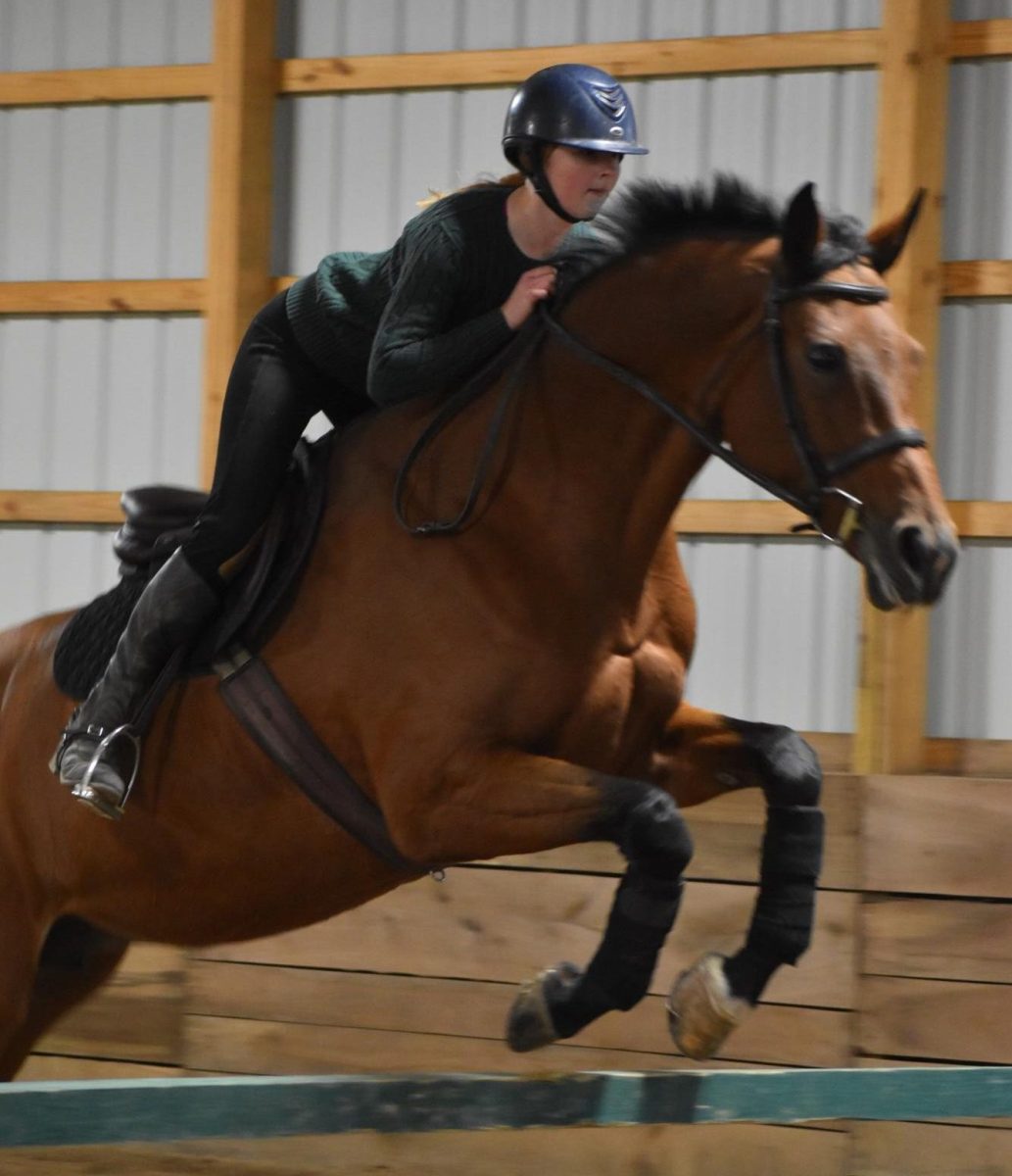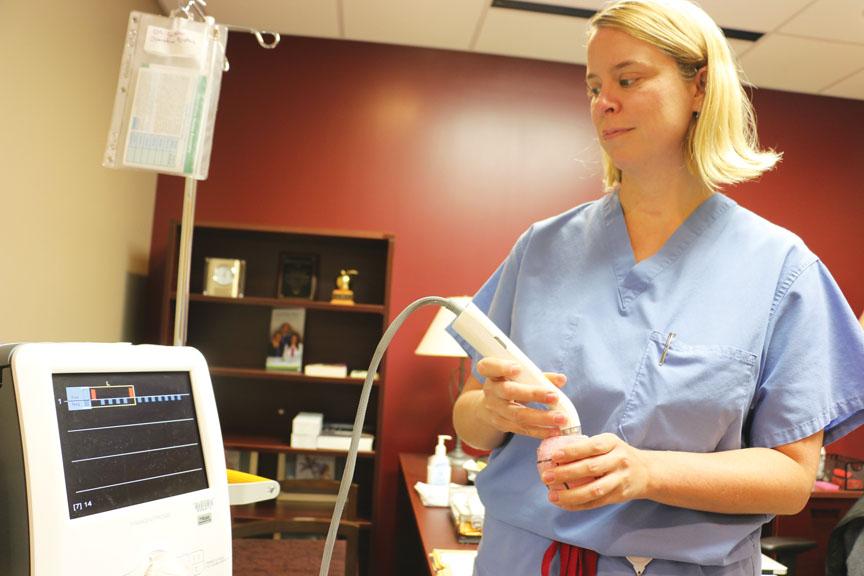Jeanne Adaniya is an instructional assistant at CHS and a breast cancer survivor. Five years ago, a surgeon diagnosed Adaniya with Stage 3 inflammatory breast cancer after finding a small spot on her skin. The first doctor she visited diagnosed her with eczema, but recommended she visit a specialist just in case.
After a consultation with surgeon Timothy Goedde, Adaniya got a biopsy done at Community North Hospital. Three days later, Goedde told her the spot came back positive for breast cancer.
“Personally, I did not take this very well,” Adaniya said. “I mean, it’s a very frightening thing and to me, I was particularly frightened because my mom had died of breast cancer. I had a good friend who had died of breast cancer. So I was very concerned about it, mostly about telling my three daughters.”
Adaniya was given her entire treatment plan ten days after diagnosis.
She said, “The Monday after my diagnosis, I had a port inserted, and then the day after I had my first dose of chemo.”
After her diagnosis, Adaniya had 12 chemotherapy treatments, three surgeries and 36 radiation treatments. The entire treatment lasted a year.
“Many people think after being diagnosed, you are completely alone, and that scares them, but at least with me, I had a nurse, called a ‘breast navigator’ who literally guided me through my entire treatment,” she said.
Unlike Adaniya, current breast cancer patients now have a much simpler treatment plan.
Recently, St. Vincent’s Hospital has added new tools for early breast cancer detection and have a less invasive treatment approach.
Dr. Erica Giblin, breast cancer surgeon at St. Vincent’s, said two new pieces of technology were introduced, and both show promising results in response to breast cancer.
The first new piece of technology is called “radioactive seed localization,” which allows doctors to easily locate cancer in the breast tissue. An iodine seed with low-levels of radiation is placed in a specific lesion, then the doctor uses a probe to pinpoint the exact location of the cancer.
“It helps us hone in and be much more accurate in the tissue that we take out, and allows us to take out a smaller amount of tissues instead of filing a wire down (into breast tissue) and taking a huge piece of unnecessary tissue out,” Giblin said.
Giblin said the previous approach was much more invasive.
“The old standard would be getting a mammogram of the breast and a radiologist would insert a thin wire to the targeted area. The wire pokes out of the skin. This is very scary to patients,” Giblin said.
The wire can also shift and move, which decreases the ability to treat the target area, according to Giblin.
The second new tool added to St. Vincent’s cancer program is called the MarginProbe.
Giblin and other doctors use this technology to test the tissue they extract from patients. According to Giblin, the MarginProbe analyzes the edges of the tissue and can detect subtle cellular changes in the tissue edge to see if it contains cancer.
Since surgeons can make sure the margins of the tumor are cancer-free with the MarginProbe, it helps prevent having to take patients back to the operating room for additional surgeries by 50 percent. The probes will help catch cancer much earlier than older technology.
Giblin said if doctors are able to catch cancer earlier, they can do much less invasive surgeries. In other words, the earlier the cancer is found, the faster doctors and surgeons can find ways to stop it.
Adaniya said she believes that new technology will relieve stress from patients, as well.
“There were situations where (the doctors) would call you two days after an appointment and leave a message on your machine saying we have some questions we need you to come back and just the anxiety it caused was at a high level. So, what this new technology does is (it) eliminates the possibilities for false positives,” she said.
St. Vincent’s started using this technology in September after Giblin saw it used during her training.
“I had learned about these specific technologies during my fellowship and thought these technologies would be very beneficial to the hospital. So, I asked the hospital to look to it, and obviously the hospital was very interested in this because it’s completely safe and helps the patient greatly,” Giblin said.
St. Vincent’s is the only hospital in central Indiana that offers this innovative technology. However, this new technology does not replace the breast Magnetic Resonance Imaging (MRI).
“Breast MRI is still very important as it takes a different kind of picture of the breast and it definitely still has a place in breast cancer imaging,” Giblin said.
New technology like this has an impact on the children of those with breast cancer, such as sophomore Kate Adaniya, Mrs. Adaniya’s daughter.
“From what I remember (of my mother telling me about her cancer), I cried one tear but apparently I was sobbing,” Kate said. “Since I was only a ten-year-old, I didn’t know exactly know what was happening at this point. I didn’t know if I was going to lose my mom, and I definitely didn’t know what would happen if I did,” she said.
After her experience with her mother’s cancer, Kate said she is in favor for new breast cancer technology.
“Anything that will help patients with breast cancer will not only be beneficial to them, but reduce the stress of family members as well,” Kate said.
Mrs. Adaniya said she agrees.
“Anything that can give people the peace of mind of having this testing and being told that you don’t have any signs of cancer is very positive emotionally and important from a treatment standpoint as well,” she said. “So then, patients are more motivated to get the mammograms and tests and scans that will help their treatment, rather than being scared of these things.”
She said, “As a breast cancer survivor, what I’ve learned is to be hopeful. We should remember that the vast majority of people survive breast cancer and with the help of new technology we can definitely find a way to decrease the amount of deaths caused by breast cancer.”


































![British royalty are American celebrities [opinion]](https://hilite.org/wp-content/uploads/2024/03/Screenshot-2024-03-24-1.44.57-PM.png)


















![Review: “Suits” is a perfect blend of legal drama and humor [MUSE]](https://hilite.org/wp-content/uploads/2024/04/unnamed-1.png)
![Chelsea Meng on her instagram-run bracelet shop [Biz Buzz]](https://hilite.org/wp-content/uploads/2024/04/IMG_2446-1200x838.jpg)
![Review: Quiet on Set: The Dark Side of Kids TV is the long awaited exposé of pedophilia within the children’s entertainment industry [MUSE]](https://hilite.org/wp-content/uploads/2024/04/unnamed.jpg)
![Review: “The Iron Claw” cannot get enough praise [MUSE]](https://hilite.org/wp-content/uploads/2024/04/unnamed.png)
![Review: “The Bear” sets an unbelievably high bar for future comedy shows [MUSE]](https://hilite.org/wp-content/uploads/2024/03/unnamed.png)
![Review in Print: Maripaz Villar brings a delightfully unique style to the world of WEBTOON [MUSE]](https://hilite.org/wp-content/uploads/2023/12/maripazcover-1200x960.jpg)
![Review: “The Sword of Kaigen” is a masterpiece [MUSE]](https://hilite.org/wp-content/uploads/2023/11/Screenshot-2023-11-26-201051.png)
![Review: Gateron Oil Kings, great linear switches, okay price [MUSE]](https://hilite.org/wp-content/uploads/2023/11/Screenshot-2023-11-26-200553.png)
![Review: “A Haunting in Venice” is a significant improvement from other Agatha Christie adaptations [MUSE]](https://hilite.org/wp-content/uploads/2023/11/e7ee2938a6d422669771bce6d8088521.jpg)
![Review: A Thanksgiving story from elementary school, still just as interesting [MUSE]](https://hilite.org/wp-content/uploads/2023/11/Screenshot-2023-11-26-195514-987x1200.png)
![Review: When I Fly Towards You, cute, uplifting youth drama [MUSE]](https://hilite.org/wp-content/uploads/2023/09/When-I-Fly-Towards-You-Chinese-drama.png)
![Postcards from Muse: Hawaii Travel Diary [MUSE]](https://hilite.org/wp-content/uploads/2023/09/My-project-1-1200x1200.jpg)
![Review: Ladybug & Cat Noir: The Movie, departure from original show [MUSE]](https://hilite.org/wp-content/uploads/2023/09/Ladybug__Cat_Noir_-_The_Movie_poster.jpg)
![Review in Print: Hidden Love is the cute, uplifting drama everyone needs [MUSE]](https://hilite.org/wp-content/uploads/2023/09/hiddenlovecover-e1693597208225-1030x1200.png)
![Review in Print: Heartstopper is the heartwarming queer romance we all need [MUSE]](https://hilite.org/wp-content/uploads/2023/08/museheartstoppercover-1200x654.png)






















![Review: Ladybug & Cat Noir: The Movie, departure from original show [MUSE]](https://hilite.org/wp-content/uploads/2023/09/Ladybug__Cat_Noir_-_The_Movie_poster-221x300.jpg)

![Review: Next in Fashion season two survives changes, becomes a valuable pop culture artifact [MUSE]](https://hilite.org/wp-content/uploads/2023/03/Screen-Shot-2023-03-09-at-11.05.05-AM-300x214.png)
![Review: Is The Stormlight Archive worth it? [MUSE]](https://hilite.org/wp-content/uploads/2023/10/unnamed-1-184x300.png)




![Seniors Jillian Rang and Athul Ramkumar practice their presentation at the DECA state competition on March 5, 2024. Arya Patel, DECA paper head and junior, said, As they [students] begin to make their final preparations, its important to remember that making it to this point is an incredible achievement.](https://hilite.org/wp-content/uploads/2024/04/IMG_8285-1200x800.jpg)

